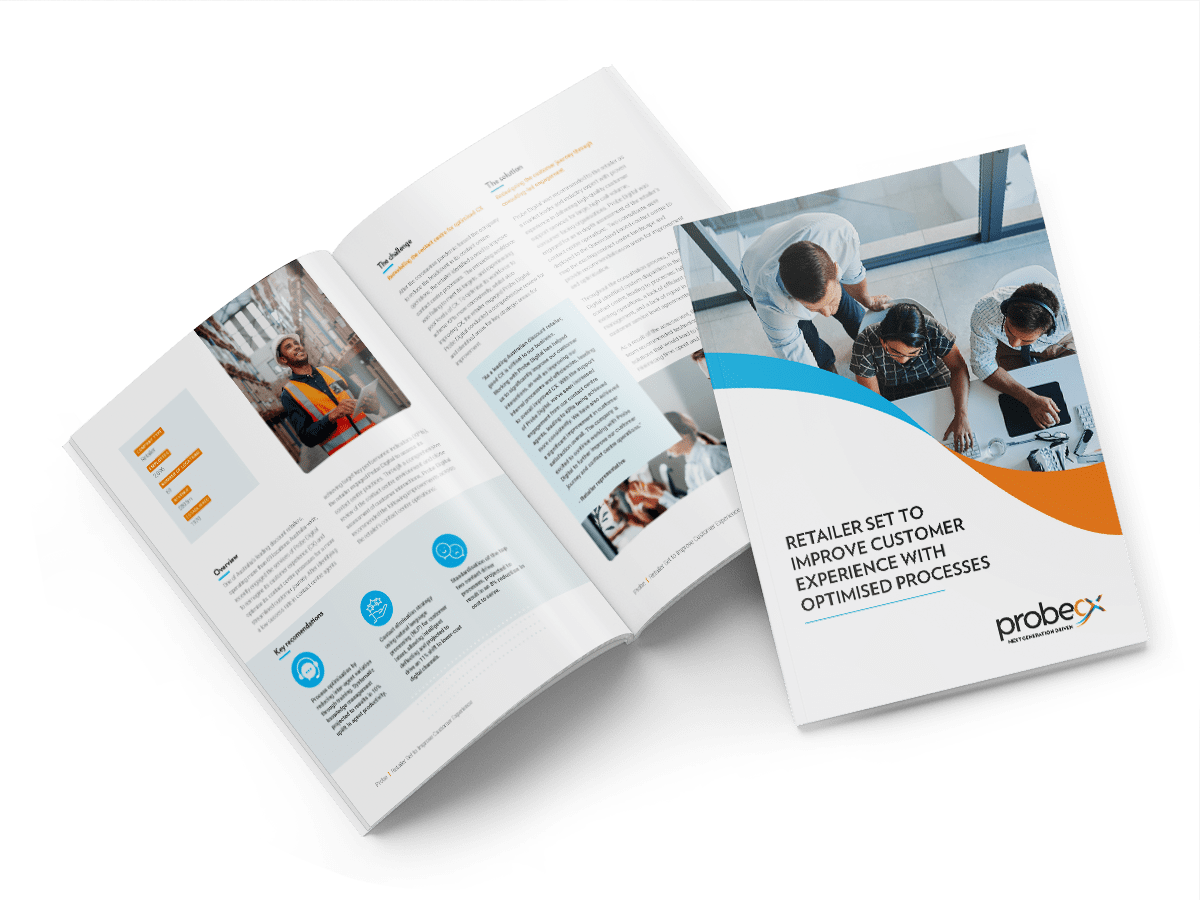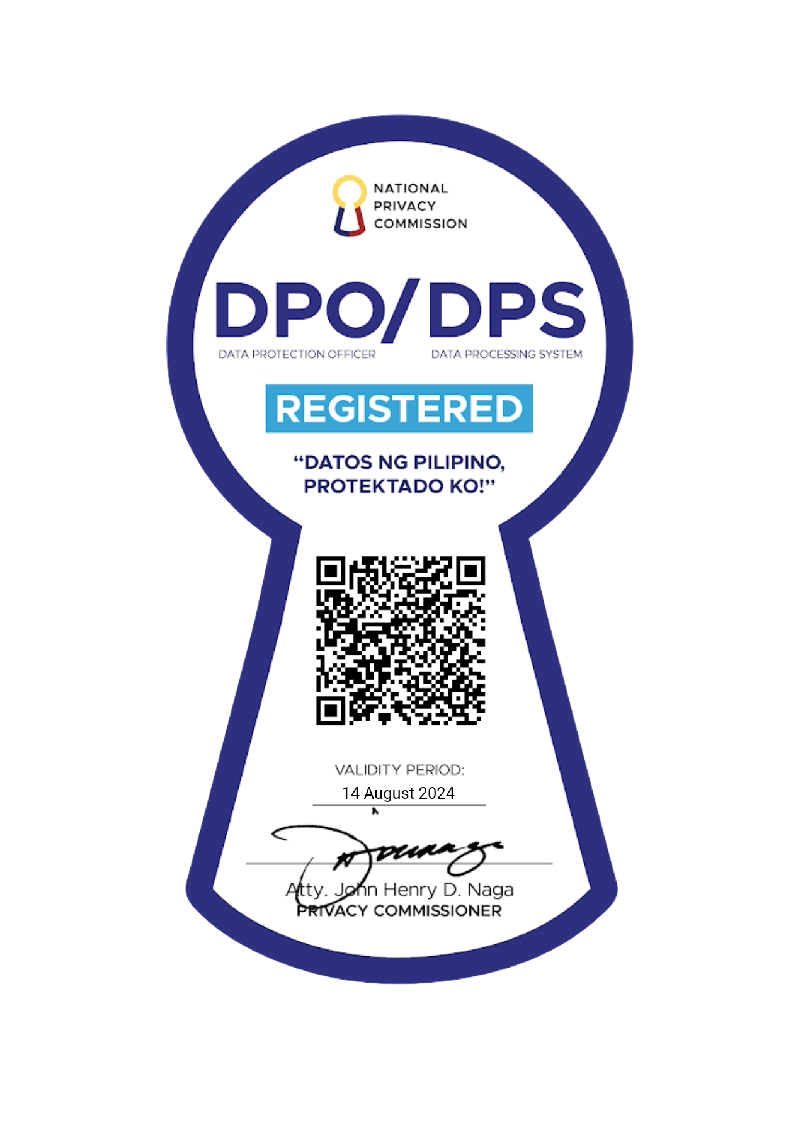-
About Us
Probe CX is a tech-powered, global customer experience organisation that amplifies human capabilities with technological excellence.
-
Vision and Culture
We help our clients become modern digital organisations by combining the latest technology with people, process and data.
-
Executive Team
Meet the team with unmatched experience committed to helping organisations create environments for digitally-enabled CX to thrive.
-
Compliance
Industry-recognised certifications to protect what matters most to our clients and their customers.
-
Locations
Over 19,000 team members delivering exceptional customer experiences across five countries.
-
Reasons to choose Probe CX
The top nine reasons to get more closely acquainted with Probe CX.
TECHNOLOGY & TRANSFORMATION SERVICES
 Creating exceptional customer experiences by 'doing it better'
Creating exceptional customer experiences by 'doing it better'
Optimise your customer experience by designing, deploying and managing digital solutions customised to your unique needs.
Continue reading- Blog
- Boost your candidate experience in 7 simple steps
Boost your candidate experience in 7 simple steps

Just as in real estate when they say it’s a ‘sellers’ or ‘buyers’ market, in the recruitment world, it’s a ‘candidate's market’. No longer are hiring managers or recruiters in control. It’s not as simple as just placing a job ad and having pools and pools of applicants to choose from. In the current climate, those looking for a job have become more specific and aware of the organisations they choose to work for and precisely what is on offer for them. Salary isn’t the only bargaining point anymore.
So what can organisations do to stay on top of these changing candidate expectations? How can they position themselves to become THE employer of choice for reasons other than ‘close to public transport’ or ‘competitive salary’? It takes a complete review of the candidate experience. While employee experience focuses on fostering happy and motivated existing teams, candidate experience is all about igniting this in your future employees.
In this blog, we explore the statistics behind why candidate experience is important, the benefits of having a positive candidate experience and how you can improve your organisations.
![]()
The candidate experience explained
What is a candidate experience? It is how those looking for work ‘react to an organisation’s recruitment cycle’. This covers everything from the sourcing and attraction stage, through assessment, interview, offer and finally, the onboarding process.
It covers every interaction your organisation has with any and all candidates in the job market - not just the ones actively interested in joining your company. To improve your candidate experience, most strategies require the complete re-evaluation of all the touchpoints a person may have with your organisation.
The majority of these touchpoints exist during the recruitment stage. Why? Well, you are most actively running campaigns, job ads or search activity. So naturally, your organisation is going to come up a lot more during job searches and research activities - at least hopefully, if you’re using the right hiring processes and recruiting software.
What makes up these candidates' experience touchpoints can be filtered into the following:
- The initial job search: anything from a job advertisement placed on Seek, Indeed or LinkedIn, a post on social media advertising a new position or even a link on your company’s careers pages.
- The job application: the part of the advertisement or informative link that tells potential candidates how to apply for the role advertised or how they can supply details for your company to get in touch.
- The pre-interview stage: the very first point of contact post job application being received. This could be the automatic email that gets sent out letting them know a company representative will be in touch or the first call to introduce your company and organise a potential interview.
- The interview/assessment stage: how the interview/assessment is structured, how many interviews are to be conducted for the position, whether multiple people need to interview the candidate, what information the candidate needs to supply, where the interview takes place, the length and the type of questions asked.
- The post-interview stage: the method of communication and the way you let interviewed candidates know they have progressed or not progressed to the next stage of the hiring process. This part is crucial in maintaining a long term candidate experience if they are unsuccessful. This can also include reference checks and negotiating contracts with applicants who are successful.
- The post-offer, pre-commencement stage: the contact between recruitment, the hiring manager and onboarding team with the new hire to keep them engaged and enthusiastic about joining your organisation.
- The onboarding process: the structure of their first day or week, buddy programs, support and knowledge sharing on how to form relationships with key people in the business, how new employees are trained, and whether they are provided with the right and necessary resources they need to efficiently get their job done.
48% of job seekers also base their candidate experience on the ‘passive’ stage, so it’s important to ensure that your organisation is also looking at elements outside of the active recruitment period. This could include a robust career site that includes employee feedback on why they enjoy working for the company, managing your organisation's SEO, consistent branding across all market-facing communication, check-in emails with unsuccessful candidates, campaigns that showcase your organisation’s culture or employee experience drives and so on.
![]()
Why a positive candidate experience makes all the difference
It should be starting to click that positive candidate experiences can ‘make or break’ a successful recruitment drive. This directly impacts your organisation's ability to hire quality candidates too. The facts speak for themselves and explain how each one of these candidate experience touchpoints is as important as the other.
Check out the following statistics that illustrate the importance of a good vs poor candidate experience:
- 81% of job seekers will share a good candidate experience with their network
- If candidates have a positive experience, they are 38% more likely to accept job offers from that business
- Providing constructive feedback to unsuccessful job applicants will lead to those candidates becoming four times more likely to reconsider your business for future open job positions
- 87% of job applicants said a positive interview experience can make them reconsider a job they doubted, while 83% state that a negative interview experience can make them change their mind about continuing to pursue a job entirely
- Application processes that are deemed too complex or too lengthy cause 60% of candidates to not complete or withdraw their interest in a role
- Job seekers that have poor candidate experiences are 72% more likely to share their experience online via employer review websites
- 72% of hiring managers believe their job descriptions are accurate for advertised positions, while 36% of candidates believe they are not clear enough.
In their 2021 Candidate Experience Report, CareerPlug explained the most common reasons candidates decline a job offer and it ultimately came down to their overall candidate experience. They also asked these candidates how important the recruitment process is to their overall experience. They asked job seekers to rate this on a scale of 1 through to 10 with 10 being very important. They found the overwhelming response to be between an 8 and a 10.
![]()
7 simple steps to a better candidate experience
Based on these statistics, your next step should be to understand how to facilitate a better, more seamless candidate experience. Here is how you can get started:
- Revisit your interview processes
Often, one of the first interactions between the hiring manager and the potential candidate, the interview can set the tone for the rest of the recruitment process. Getting it wrong could lead to employees not wanting to pursue anything further with their application.
Research effective interview questions, don’t make them too lengthy or complex (unless the job role requires certain technical capabilities to be addressed) and make sure you offer them a chance to ask questions too. Maybe take them for a tour around the office, or consider providing refreshments. Give them an opportunity to really see your office culture and insight into where they fit in. - Ensure your application process is simple, efficient and seamless
Did you know that job seekers can spend around three to four hours submitting a single job application? Imagine if you were in an applicant's position, put yourself in their shoes for just a second. Although we like to hope that job seekers are only applying to our company, the reality is far from that.
It will look favourably upon your business if your application process is clean and not overly complicated. Take time to revise your entire process from the beginning. Can an applicant apply from different types of electronic devices? Is it optimised for mobile use? Does your ATS parse information from the CV? Is auto-fill functionality enabled? These things can save a candidate time and increase the chances of them completing their application.
Try to reverse engineer the process by cutting out unnecessary questions that may be better asked in the interview stage instead. - Implement recruitment marketing tactics
Research inbound marketing initiatives that focus on proactively attracting candidates that are best suited to your company. Think recruitment marketing tactics that connect with both passive and active candidates. Keep up regular posting schedules for your company or implement a careers website focused entirely on recruitment and employee experience. Promote employee testimonials on said social media posting schedules or consider career development tips and seminars. - Be transparent
Clear recruitment process expectations improve around 83% of job seekers overall candidate experience. Don’t hide anything. Talk candidates through the entire recruitment process in detail so they know what to expect, how best to present themselves and feel confident in their ability to do so. How many references will they need to provide, what documents will they need to bring to this interview and whether you’ll be performing candidate screening checks. - Create informative and clear job descriptions
Make sure to list out the relevant job responsibilities, but, place more focus on including information that would peak a job seeker's interest. These include the potential salary range, additional benefits, career progression opportunities, where the role fits within the business, who they report to, and an accurate representation of company values. Don’t overwhelm them, but make sure they are easy-to-read, such as dot points. - Ask for and give feedback constantly
Even if you decide that an applicant will not progress further in the application process, make sure to give them constructive feedback on why this is the case. Remember, this isn’t the only recruitment drive your business will undertake. By providing constructive feedback as to what a candidate may lack today, they may come back in a year or two with the skills necessary to excel in the position.
And don’t hesitate to ask how you could have made their candidate experience more enjoyable either - if there is something that bugged them during the whole process, chances are, it may impact someone else poorly too. - Don’t lose touch
Regardless if a candidate is successful or not, keep in touch. With unsuccessful candidates, a simple connection on LinkedIn as an example is enough to keep track of what they are up to and share insights or development courses that could make them a great fit in the future. With successful candidates, the same applies.
You never know when an internal promotion opportunity arises. Creating candidate pools is a great way to check-in with them or notify them of a role they are now really well suited to that’s currently available. The additional value this will give candidates will make you a preferred employer through the simple act of just being there and being active.
![]()
The connection between candidate experience and customer experience
For organisations looking to improve their candidate experience, it’s best to start at the function that plays a huge role in it all: recruitment and HR. A happy candidate leads to an even happier and motivated employee. These positive candidate experiences can lead to positive employee experience which then translates through to positive customer experiences.
Related Articles
Shared Services
4 ways to manage overflow
Top overflow solutions to help improve your overall customer experience in times of peak demand.
Technology
How to get started with intelligent automation
RPA can create growth opportunities and reduce operational costs but it is not a 'one size fits all' concept. Learn more in this blog here.
Technology
6 key digital transformation trends
Learn how these six trends can help your business drive growth and innovation in a rapidly changing digital landscape.
© Copyright 2024 Probe CX | All Rights Reserved
Privacy Policy | Financial Hardship Policy | Whistleblower Policy | Complaints Procedure | Supplier Code of Conduct | Make a Payment | Client Login





